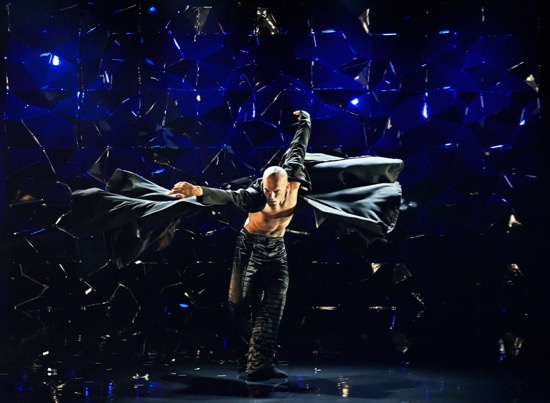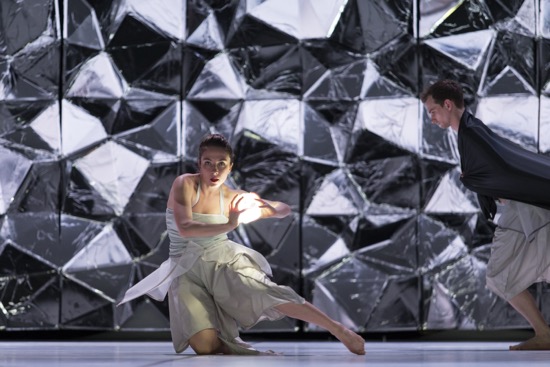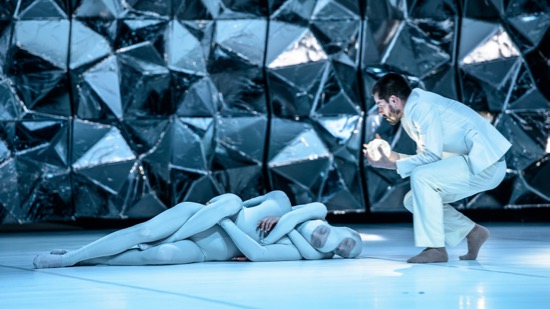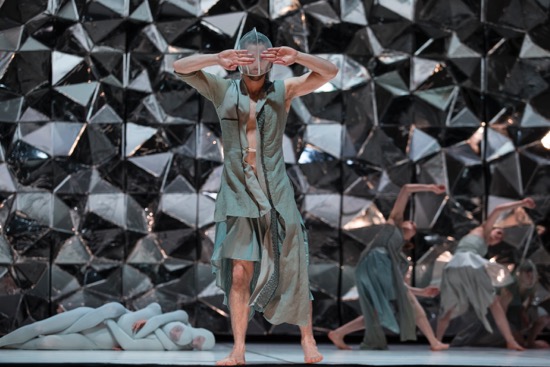Danish Dance Theatre comes to the Joyce Theater, October 13-16.

Alessandro Sousa Pereira in Tim Rushton’s Black Diamond. Photo: Henrik Stenberg
Help! I’ve been sucked into a nightmarish world known only to people who’ve seen too much dance. Its inhabitants seem familiar; they can thrust a leg sky-high, twist themselves into knots, and hurtle to the floor. They’re not afraid to look awkward or ugly and look wonderful—even virtuosic— doing that. They know that we’re staring into their world, whatever it is, and they stare back. The women are as bold and strong as the men, but on occasion, they allow themselves to be manhandled ferociously.
These heroic, beleaguered people on view at the Joyce Theater are thirteen members of the Danish Dance Theatre; they’re performing Tim Rushton’s two-act Black Diamond in New York; Washington, D.C.; and Chicago, before returning to Europe. Rushton, once a member of the Royal Danish Ballet, has headed this contemporary-minded company (founded in 1981) since 2001. As for the “territory” the performers inhabit, Rushton’s program note says, in part, that, with this dance, he “returns to an abstract universe, focusing on the aesthetic and form.” Using a cut diamond’s sharp edges and angles as a source for movement may sound abstract, but Rushton’s piece wanders between dancing as physical ardor and dancing as dramatic encounters in perplexing ways.

CSongor Szabo (L) and Alessandro Sousa Pereira in Black Diamond. Photo: Henrik Stenberg
The atmosphere is that of familiar contemporary culture mixed with worlds-of-the-future enigmas. It’s a cold place. The dancers wear various, interestingly cut outfits by Charlotte Østergaard, ranging from draped and gathered pale gray dresses (all slightly different) to long black coats, unfastened in front, that fly out when the wearers dance, making them look like giant crows. Their flesh provides the only color. Johan Kølkjaer’s backdrop shows a dense pattern of straight-edged shapes that fool you by appearing three-dimensional; it took me while to notice that small mirrors embedded in it reflect fragments of the action.
Over Black Diamond’s two acts, the denizens of this world contend with fourteen pieces of recorded music credited to Trentemøller, the Balanescu Quartet, Philip Glass, and Tom Opdahl—almost all of it loud, aggressive, and thick in terms of texture. At some point in Act II, I wanted to stuff something in my ears.
For an abstract universe, Rushton’s dance confronts us with a plethora of unfulfilled desires (this is the trouble with dancers: they’re living people, and we tend to interpret their behavior as we do with any person we meet or see in passing). Perhaps they’re continually jerking and wrenching themselves around, or making pressured, fluid movements culminate with a jolt, because of the diamond imagery, but, given these dancers’ extreme physical ability, they tend to look as if they’re being subjected to electric shocks or are beset by serious inner troubles or are being turned into robots and fighting that possibility. Amazing how swiftly they can drop to the floor and recover into an alert, squatting stance. On the other hand, they may squirm along like worms in distress or position their arms in angular shapes reminiscent of offering-bearing Egyptians in a frieze.
Certainly, they’re not weaklings. In my mind’s eye, I remember them primarily hunkered down and ready for combat—their legs wide-spread and their knees bent. Still, in one passage, the arm gestures of dancers working in vigorous unison include pulse-taking.

Arina Trostyanetskaya (former member of Danish Dance Theatre) in Tim Rushton’s Black Diamond. Photo: Costin Radu
So, okay, diamonds. . .black ones. But there’s more going on here than character studies of minerals. This is a hard-edged, idiosyncratic society; light glances off them and makes them crazed. Men tend to work together; women may suddenly rush on in a flock. Luca Marazia is curled up on his side when the curtain goes up, and he comes and goes throughout the work, entering and leaving casually, even though while he’s onstage, he’s inquisitive; like an anthropologist observing the natives, he occasionally copies them and is once turned upside down by a bunch of them. He’s protective of an irregularly textured, transparent sphere, a bit bigger than a croquet ball, which periodically lights up from within. I didn’t notice anyone fighting over it, although one cave-man-like motif has the performers’ keeping their hand, about a foot apart and moving them as if turning a large, invisible ball between their palms.
Rushton often designs what’s essentially rough-and-tumble in extremely interesting ways, Nevertheless, I begin to find myself muttering silently to the performers. I say things like “Why did you do that?” and “Wait, didn’t he just give you a very hard time? and “Where have you been?” and “What is it you want?” and “Why the masks now?”. I never did figure out the significance of the woman in a full-skirted black dress, with an elaborate collar of some kind, who twice scrabbled across the floor like a wounded animal making its escape and disappeared.

Martin Garside (in the role now taken by Luca Marazia) approaches Milou Nuyens and Jernej (another former company member). Photo: Soren Meisner
I’m entranced by how, as Act II begins, two hooded, faceless, gray-clad dancers (Milou Nuyens and Joe George) are lying on the floor, their limbs braided together (no, really), and they remain motionless that way for a long time while others (Merete Hersvik prominent among them) dance. The duet for the two brings us to familiar robot territory; these can stretch and curl in intriguing ways, as well as jerk around while prolonging their learning experience. Marazia moves them into various positions. But although he brings them together, an awkward ballroom dance hold is as close to an embrace as they can manage; others carry them away, stiff and horizontal. Then the men “punish” Marazia by yanking him around.
In Act I, there’s a scene in which Alessandro Sousa Pereira and Stefanos Bizas get Lucia Pasquini between them and start pulling her around—lifting her, swinging her, dragging her. A couple more men arrive to help. There’s a puzzle built into this kind of a scene. The men are nominally in charge, but the woman—while looking desperate and unhappy—actually has to run to them so they can maul her some more. Rushton hasn’t presented this as a ritual; it’s just one more day in this supposedly “abstract” dance. And when it’s over, Pasquini joins the five other women in a vigorous dance (they wear transparent head-coverings, she does not), as if nothing momentous has happened to her.
Among the most intriguing—if mysterious—events is a trio for, I believe, Sousa Pereira, Emily Nicolau, and Fabio Liberti. They stand in a downstage corner and touch themselves in a business-like way (the pulse-taking comes here), and their gestures accord perfectly with ringing tones in the sound score. Another resonant image that appears out of nowhere: each of the men, straining forward, drags a long piece of fabric on which one of the women stands, staring past us, as immobile as a department store dummy. As one disappears, another enters, and another, and another. The last to cross bears the female robot.

CSongor Szabo, masked, in Black Diamond. Photo: Costin Radu
It’s as if Rushton had collected a series of movement images that intrigued him and intersected with his “diamond” idea (including you can cut yourself on one?) and seamed them together, with Marazia as the traveler passing through new villages with strange customs. But the result is baffling.
So is the ending—a resolutely happy one in Rushton’s mind. Tall Nicolau stands facing us, while Marazia gently and slowly undresses her. Naked and isolated in light, she walks toward the audience—in Rushton’s program note, “the symbol of a hopeful and sensitive humanity.”
That aroused me to consider what it was that I missed in Black Diamond, beside a through line of some kind to guide us through its eclectic landscape. The dancers are diverse in every way (they hail from ten different countries, with only two Danes in the mix). And they are compelling, including those I haven’t yet mentioned: Maxim-Jo Bech McGosh, Csongor Szabo, Jessica Lyall, and Lukas Hartvig-Møller. But they seem to have no agency in what they do—that is, an intent that would drive them through what comes to seem like a catalogue of physical ordeals in a hostile environment.

Sounds to me like a “kitchen sink” piece Deborah, one that isn’t everything but, but includes a double sink. Thanks, as usual, for the eloquent writing.